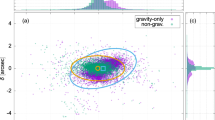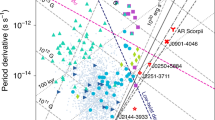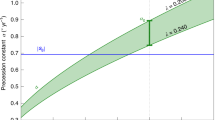Abstract
Dynamical resonances in the asteroid belt are the gateway for the production of near-Earth asteroids1 (NEAs). To generate the observed number of NEAs, however, requires the injection of many asteroids into those resonant regions. Collisional processes have long been claimed as a possible source1,2,3, but difficulties with that idea have led to the suggestion that orbital drift arising from the Yarkovsky effect4,5,6,7 dominates the injection process8,9,10. (The Yarkovsky effect is a force arising from differential heating—the ‘afternoon’ side of an asteroid is warmer than the ‘morning’ side.) The two models predict different rotational properties of NEAs: the usual collisional theories2 are consistent with a nearly isotropic distribution of rotation vectors, whereas the ‘Yarkovsky model’ predicts an excess of retrograde rotations. Here we report that the spin vectors of NEAs show a strong and statistically significant excess of retrograde rotations, quantitatively consistent with the theoretical expectations of the Yarkovsky model.
This is a preview of subscription content, access via your institution
Access options
Subscribe to this journal
Receive 51 print issues and online access
$199.00 per year
only $3.90 per issue
Buy this article
- Purchase on Springer Link
- Instant access to full article PDF
Prices may be subject to local taxes which are calculated during checkout

Similar content being viewed by others
References
Greenberg, R. & Nolan, M. C. in Asteroids II (eds Binzel, R. P. et al. ) 778–804 (Arizona Univ. Press, Tucson, 1989)
Davis, D. R., Weidenschilling, S. J., Farinella, P., Paolicchi, P. & Binzel, R. P. in Asteroids II (eds Binzel, R. P. et al.) 805–826 (Arizona Univ. Press, Tucson, 1989)
Zappalà, V., Cellino, A., Di Martino, M., Migliorini, F. & Paolicchi, P. Maria's family: physical structure and possible implications for the origin of giant NEAs. Icarus 129, 1–20 (1997)
Vokrouhlicky, D. Diurnal Yarkovsky effect as a source of mobility of meter-sized asteroidal fragments. I. Linear theory. Astron. Astrophys. 335, 1093–1100 (1998)
Vokrouhlicky, D. A complete linear model for the Yarkovsky thermal force on spherical asteroid fragments. Astron. Astrophys. 344, 362–366 (1999)
Vokrouhlicky, D. & Farinella, P. The Yarkovsky seasonal effect on asteroidal fragments: A nonlinearized theory for the plane-parallel case. Astron. J. 116, 2032–2041 (1998)
Spitale, J. & Greenberg, R. Numerical evaluation of the general Yarkovsky effect: Effects on semimajor axis. Icarus 149, 222–234 (2001)
Bottke, W. F., Jedicke, R., Morbidelli, A., Petit, J. & Gladman, B. Understanding the distribution of near-Earth asteroids. Science 288, 2190–2194 (2000)
Bottke, W. F. et al. Debiased orbital and absolute magnitude distribution of the near-Earth objects. Icarus 156, 399–433 (2002)
Morbidelli, A. & Vokrouhlicky, D. The Yarkovsky-driven origin of near-Earth asteroids. Icarus 163, 120–134 (2003)
Pravec, P., Harris, A. W. & Michalowski, T. in Asteroids III (eds Bottke, W. F. Jr et al.) 113–122 (Arizona Univ. Press, Tucson, 2002)
Kryszczyńska, A. Database of Asteroid Spin Vectors Determinations. 〈http://www.astro.amu.edu.pl/Science/Asteroids/〉 accessed 23 October 2003.
Kaasalainen, M. et al. Photometry and models of eight near-Earth asteroids. Icarus 167, 178–196 (2004)
Magnusson, P. et al. in Asteroids II (eds Binzel, R. P. et al.) 66–97 (Arizona Univ. Press, Tucson, 1989)
Rubincam, D. P. Radiative spin-up and spin-down of small asteroids. Icarus 148, 2–11 (2000)
Vokrouhlicky, D., Nesvorny, D. & Bottke, W. F. The vector alignments of asteroid spins by thermal torques. Nature 425, 147–151 (2003)
Cellino, A., Bus, S. J., Doressoundiram, A. & Lazzaro, D. in Asteroids III (eds Bottke, W. F. Jr et al.) 633–643 (Arizona Univ. Press, Tucson, 2002)
Acknowledgements
This work was supported by MIUR (Italy), KBN (Poland) and the Academy of Sciences (Czech Republic). We thank D. Vokrouhlicky and S. Shore for comments and suggestions.
Author information
Authors and Affiliations
Corresponding author
Ethics declarations
Competing interests
The authors declare that they have no competing financial interests.
Rights and permissions
About this article
Cite this article
La Spina, A., Paolicchi, P., Kryszczyńska, A. et al. Retrograde spins of near-Earth asteroids from the Yarkovsky effect. Nature 428, 400–401 (2004). https://doi.org/10.1038/nature02411
Received:
Accepted:
Issue Date:
DOI: https://doi.org/10.1038/nature02411
This article is cited by
-
New Yarkovsky drift detections using astrometric observations of NEAs
Experimental Astronomy (2024)
-
Topological classifications and bifurcations of periodic orbits in the potential field of highly irregular-shaped celestial bodies
Nonlinear Dynamics (2015)
-
Anomalous phase separation in La0.225Pr0.4Ca0.375MnO3: consequence of temperature and magnetic-field cycles
Applied Physics A (2011)
-
Acceleration of the rotation of asteroid 1862 Apollo by radiation torques
Nature (2007)
Comments
By submitting a comment you agree to abide by our Terms and Community Guidelines. If you find something abusive or that does not comply with our terms or guidelines please flag it as inappropriate.



